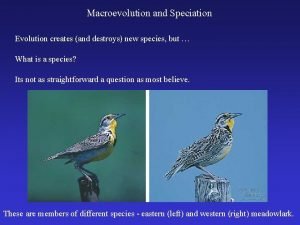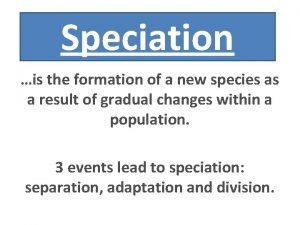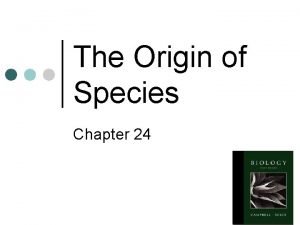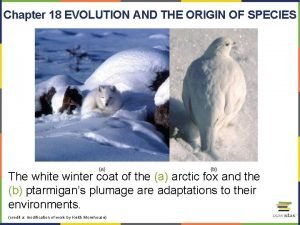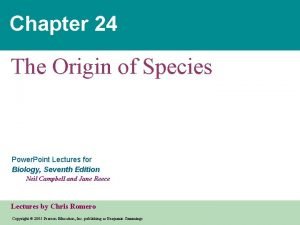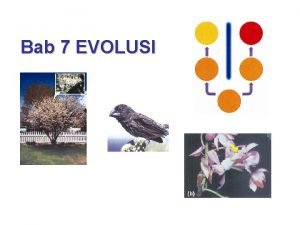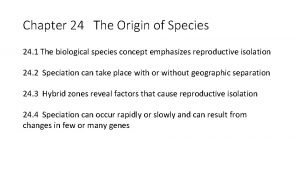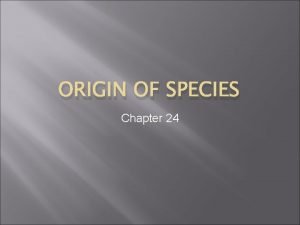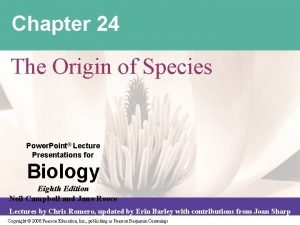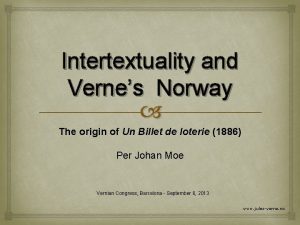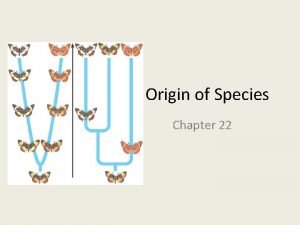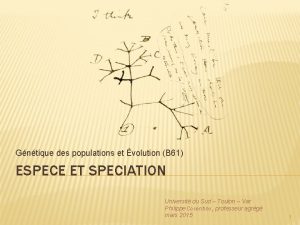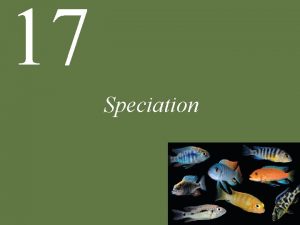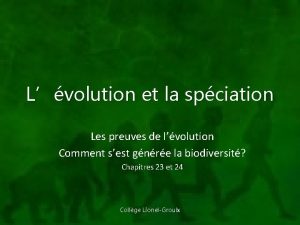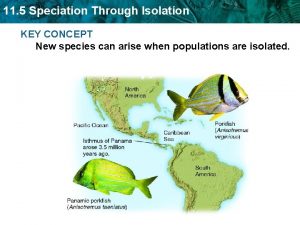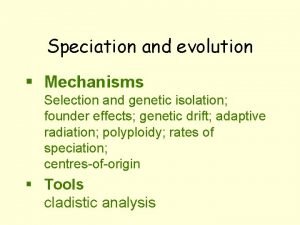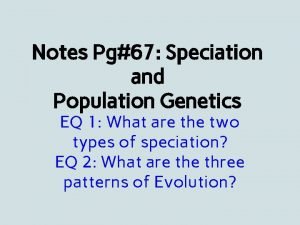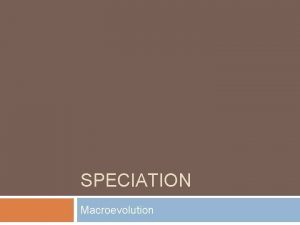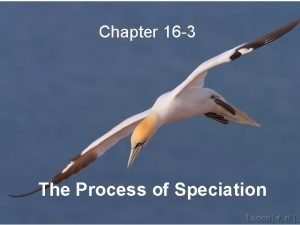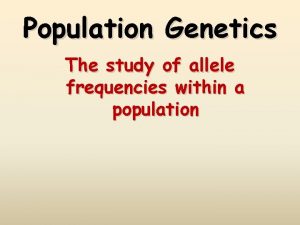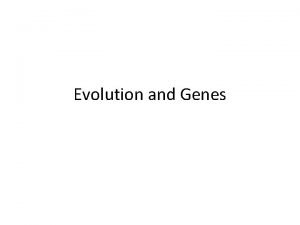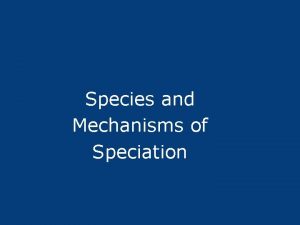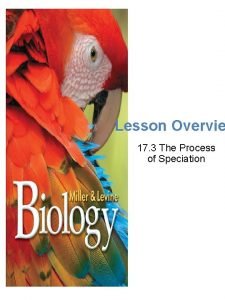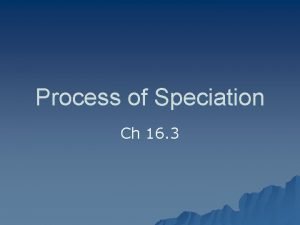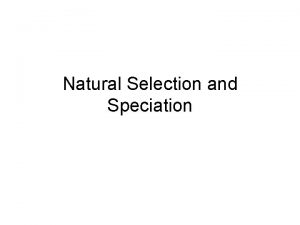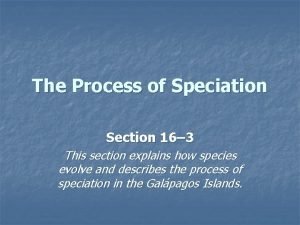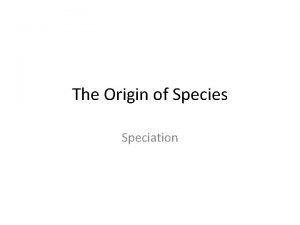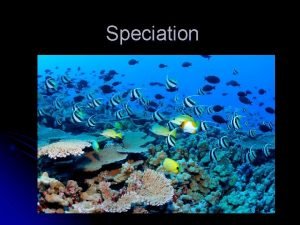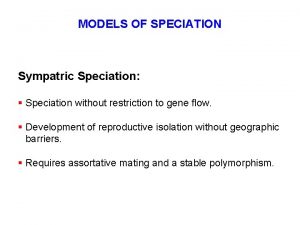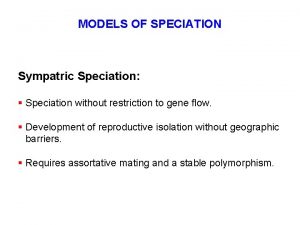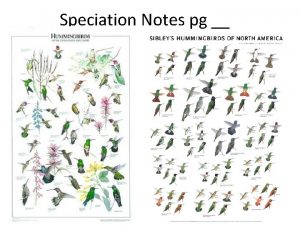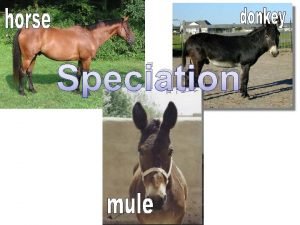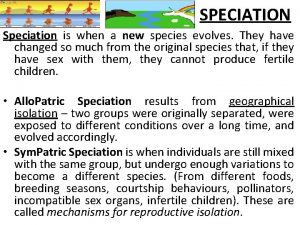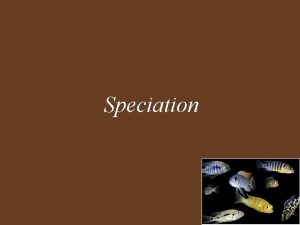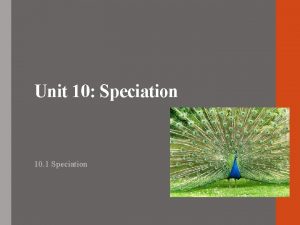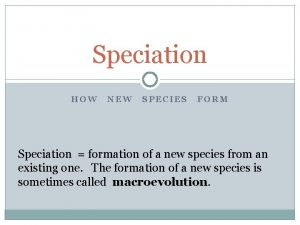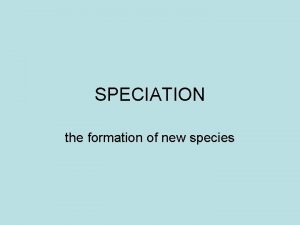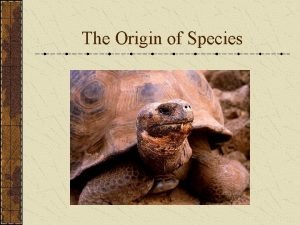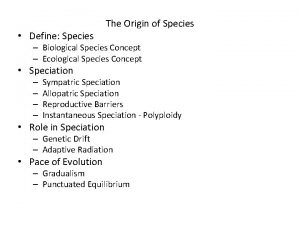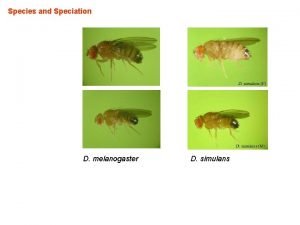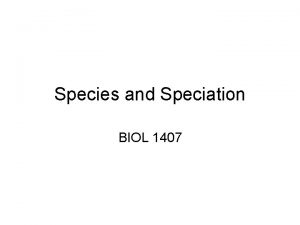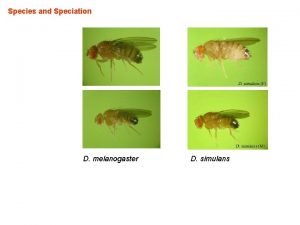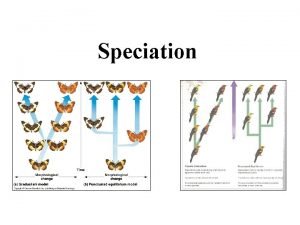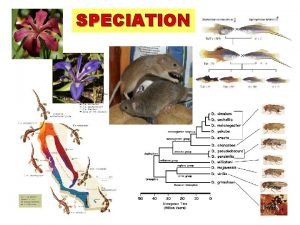The Origin of Species Speciation the origin of
































- Slides: 32

The Origin of Species

• Speciation, the origin of new species, is at the focal point of Darwin’s evolutionary theory. • Evolutionary theory must explain how new species originate and how populations evolve. • Microevolution consists of adaptations that evolve within a population, confined to one gene pool. • Macroevolution refers to evolutionary change above the species level.

• Biological species concept a species is a group of populations whose members have the potential to interbreed in nature and produce viable, fertile offspring; they do not breed successfully with other populations.

• Reproductive isolation is the existence of biological factors (barriers) that impede two different species from producing viable, fertile offspring. • Hybrids are the offspring of crosses between different species. • Reproductive isolation can be classified by whether factors act before or after fertilization.

Reproductive Barriers Between Species • Prezygotic barriers : • • • Temporal Habitat Behavioral Mechanical Gamete Isolation.

• The biological species concept cannot be applied to fossils or asexualy reproducing organisms. • morphological species concept • ecological species concept • phylogenetic species concept

• Speciation • Allopatric speciation: geographic barrier separates populations. • Sympatric speciation: no geographic barrier

• hybrid zone • A hybrid zone can occur as a single band where adjacent species meet. • Hybrids often have reduced fitness.

• When closely related species meet in a hybrid zone, there are three possible outcomes: • Reinforcement -- Strengthening of reproductive barriers reducing gene flow. • Fusion -- Weakening of reproductive barriers with eventual fusion into one species. • Stabilizing -- Continued formation of hybrid individuals.

• Evolution models • punctuated equilibrium • gradualism:

The History of Life on Earth

• Past organisms were very different • The fossil record shows macroevolutionary changes: • cumulative effect of many speciation and extinction events. • The emergence of terrestrial vertebrates • The origin of photosynthesis • Long-term impacts of mass extinctions.

• Chemical and physical processes on early Earth may have produced very simple cells • • Abiotic synthesis of small organic molecules. Joining of these small molecules into macromolecules. Packaging of molecules into “protobionts. ” Origin of self-replicating molecules.

• Earth formed about 4. 6 billion years ago, along with the rest of the solar system. • Earth’s early atmosphere likely contained water vapor and chemicals released by volcanic eruptions (nitrogen, nitrogen oxides, carbon dioxide, methane, ammonia, hydrogen sulfide). • A. I. Oparin and J. B. S. Haldane hypothesized that the early atmosphere was a reducing environment. • Stanley Miller and Harold Urey conducted lab experiments that showed that the abiotic synthesis of organic molecules in a reducing atmosphere is possible.

• However, the evidence is not yet convincing that the early atmosphere was in fact reducing. • Instead of forming in the atmosphere, the first organic compounds may have been synthesized near submerged volcanoes and deep-sea vents. • Amino acids have also been found in meteorites.

• Small organic molecules polymerize when they are concentrated on hot sand, clay, or rock. • Replication and metabolism are key properties of life. • Protobionts are aggregates of abiotically produced molecules surrounded by a membrane or membrane-like structure. • Protobionts exhibit simple reproduction and metabolism and maintain an internal chemical environment.

• The first genetic material was probably RNA, not DNA.

• Sedimentary strata reveal the relative ages of fossils. • The absolute ages of fossils can be determined by radiometric dating. • Radiocarbon dating can be used to date fossils up to 75, 000 years old. For older fossils, some isotopes can be used to date sedimentary rock layers above and below the fossil. • The magnetism of rocks also can provide dating information.

• The geologic record is divided into the Archaean, the Proterozoic, and the Phanerozoic eons. • The oldest known fossils are stromatolites, rock-like structures composed of many layers of bacteria and sediment. • Stromatolites date back 3. 5 billion years ago

• Most atmospheric oxygen (O 2) is of biological origin. • The source of O 2 was likely bacteria similar to modern cyanobacteria.

• This “oxygen revolution” from 2. 7 to 2. 2 billion years ago • Posed a challenge for life • Provided opportunity to gain energy from light • Allowed organisms to exploit new ecosystems.

• The oldest fossils of eukaryotic cells date back 2. 1 billion years. • The hypothesis of endosymbiosis proposes that mitochondria and plastids (chloroplasts and related organelles) were formerly small prokaryotes living within larger host cells • An endosymbiont is a cell that lives within a host cell.

• Key evidence supporting an endosymbiotic origin of mitochondria and plastids: • Similarities in inner membrane structures and functions. • These organelles transcribe and translate their own DNA. • Their ribosomes are more similar to prokaryotic than eukaryotic ribosomes.

• A second wave of diversification occurred when multicellularity evolved and gave rise to algae, plants, fungi, and animals. • Comparisons of DNA sequences date the common ancestor of multicellular eukaryotes to 1. 5 billion years ago. • The oldest known fossils of multicellular eukaryotes are of small algae that lived about 1. 2 billion years ago.

• The “snowball Earth” hypothesis suggests that periods of extreme glaciation confined life to the equatorial region or deep-sea vents from 750 to 580 million years ago. • The Cambrian explosion refers to the sudden appearance of fossils resembling modern phyla in the Cambrian period (535 to 525 million years ago).

• Fungi, plants, and animals began to colonize land about 500 million years ago. • Plants and fungi likely colonized land together by 420 million years ago.

• Earth’s continents move slowly over the underlying hot mantle through the process of continental drift. • Oceanic and continental plates can collide, separate, or slide past each other.

• Formation of the supercontinent Pangaea had many effects: • A reduction in shallow water habitat • A colder and drier climate inland • Changes in climate as continents moved toward and away from the poles • Changes in ocean circulation patterns leading to global cooling.

• The break-up of Pangaea lead to allopatric speciation. • The current distribution of fossils reflects the movement of continental drift. Similarity of fossils in parts of South America and Africa supports the idea that these continents were formerly attached. • The fossil record shows that most species that have ever lived are now extinct. • At times, the rate of extinction has increased dramatically and caused a mass extinction.

• The Permian extinction defines the boundary between the Paleozoic and Mesozoic eras. • This mass extinction caused the extinction of about 96% of marine animal species and might have been caused by volcanism, which lead to global warming, and a decrease in oceanic oxygen. • The Cretaceous mass extinction 65. 5 million years ago separates the Mesozoic from the Cenozoic. • Organisms that went extinct include about half of all marine species and many terrestrial plants and animals, including most dinosaurs.

• Adaptive radiation is the evolution of diversely adapted species from a common ancestor upon introduction to new environmental opportunities. • Adaptive radiations can occur when organisms colonize new environments with little competition. • The Hawaiian Islands are one of the world’s great showcases of adaptive radiation.

• Heterochrony is an evolutionary change in the rate or timing of developmental events. • It can have a significant impact on body shape. • Homeotic genes determine such basic features as where wings and legs will develop on a bird or how a flower’s parts are arranged. • Hox genes are a class of homeotic genes that provide positional information during development.
 Antelope squirrel allopatric speciation
Antelope squirrel allopatric speciation Speciation or the formation of new species is
Speciation or the formation of new species is Species
Species The origin of species chapter 24 bl
The origin of species chapter 24 bl Origin of species by charles darwin
Origin of species by charles darwin Origin of species chapter 18
Origin of species chapter 18 Chapter 24 the origin of species
Chapter 24 the origin of species The origin of species chapter 1
The origin of species chapter 1 Alopatri
Alopatri The origin of species manga 24
The origin of species manga 24 Gametic isolation
Gametic isolation Habitat isolation
Habitat isolation The origin of species bl novel
The origin of species bl novel The origin of species chapter 22 manga
The origin of species chapter 22 manga Sympatric speciation
Sympatric speciation Scala naturae
Scala naturae Speciation
Speciation La spéciation
La spéciation Reproductive isolation
Reproductive isolation Speciation
Speciation Genetic drift
Genetic drift Speciation process
Speciation process 16-3 the process of speciation
16-3 the process of speciation Genetics
Genetics Parapatric speciation
Parapatric speciation Section 16-3 the process of speciation
Section 16-3 the process of speciation Embryo development
Embryo development Speciation definition biology
Speciation definition biology Temporal isolation
Temporal isolation Example of biological species
Example of biological species Section 16–3 the process of speciation (pages 404–410)
Section 16–3 the process of speciation (pages 404–410) Speciation
Speciation Modes of speciation ppt
Modes of speciation ppt
